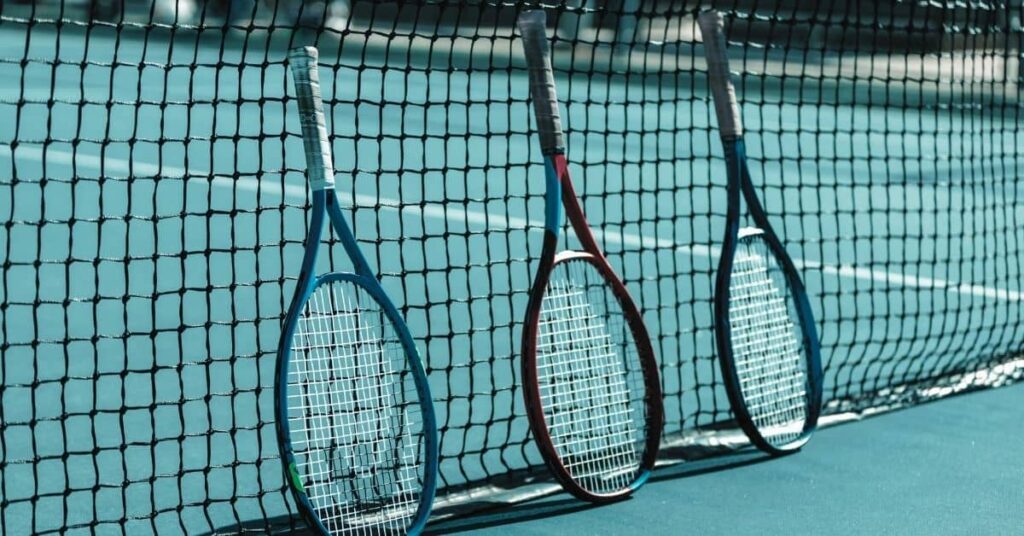I. Introduction
Choosing the right tennis racket—and comparing tennis rackets effectively—can transform your game overnight. Whether you’re chasing that perfect spin, craving pinpoint control, or seeking extra power, the racket you wield plays a starring role. In this article, we’ll dive into the top 10 rackets of 2025—starting with advanced players, then intermediates, and finishing with beginner-friendly picks. Along the way, you’ll learn how we evaluated these frames, and which factors matter most when you shop.
II. Key Factors to Consider When Buying a Tennis Racket

Picking the right racket isn’t just about the brand loyalty or looks—it’s a precise science of matching specs to your style. Below, we unpack every critical factor in vivid detail.
A. Tennis Racket Specifications Explained
- Head Size (in²)
First, head size determines how forgiving your racket is. A larger head (100 in²+) expands the sweet spot and boosts power on off-centre shots, which helps beginners find the ball more easily. Conversely, a midsize head (85–97 in²) offers precision and feedback, ideal for advanced players who rarely miss the sweet spot. - Strung Weight & Unstrung Weight (oz / g)
Next, consider weight. Unstrung weight is the racket’s bare frame; strung weight adds strings and grip. Heavier rackets (11+ oz strung) deliver stability, plow through, and dampen shock—crucial for aggressive baseliners. Lighter frames (9–10 oz) feel nimble and accelerate quickly, suiting juniors and beginners. - Balance Point (Head-Light vs. Head-Heavy)
Balance dictates how that weight feels in swing. A head-light racket (negative balance point) sits less mass toward the hoop, accelerating through the swing and aiding quick net exchanges. On the other hand, head-heavy rackets (positive balance) add momentum through contact, giving you extra power off groundstrokes. Many “tweener” frames strike a midpoint for all-around play. - Swing Weight
Swing weight measures the racket’s resistance to rotation—effectively how much “heft” you sense when you swing. A higher swing weight increases ball momentum, but it demands more arm strength and slower recovery between shots. Lower swing weights enhance manoeuvrability, letting you whip volleys and defensively block pace. - Frame Stiffness (RA Rating)
Frame stiffness reflects, how much the racket bends at impact. A higher RA rating (above 65) returns more energy to the ball—giving you explosive power—yet it also transmits greater shock to your arm. Softer frames (RA 55–60) offer more flex, cushion vibration, and reduce injury risk. Many mid-stiffness rackets (~62 RA) strike a balanced sweet spot. - String Pattern (Open vs. Dense)
Your chosen string pattern shapes spin potential and control. An open pattern (e.g., 16×19) features wider gaps between mains and crosses, letting strings bite the ball for extra topspin. However, you’ll restring more often. A dense pattern (18×20) offers predictable response, tighter feel, and enhanced longevity. - Beam Width & Cross-Section Shape
Beam width (measured in millimetres) and cross-section profile influence power and feel. Thick, boxy beams (23–27 mm) resist torsion, generating more pop off the strings. Slim, tapered beams (18–21 mm) flex more, delivering superior touch, control, and feedback—favoured by touch players and serve-and-volleyers. - Grip Size & Handle Technology
A correct grip size prevents slippage, enhances leverage, and protects against injuries like tennis elbow. Adult grip sizes range from 4 ⅛” (1) to 5” (5). If you’re undecided, err smaller—you can always layer on an over grip. Many manufacturers also integrate ergonomic handle shapes and vibration-damping inserts; read Wilson’s official grip guide for sizing tips. - Racket Length
Standard adult rackets measure 27 in. Longer rackets (27.5–29 in) extend reach on serves and groundstrokes, adding extra power through leverage. Yet they cost you some manoeuvrability at net. Junior and youth frames range from 19” to 26”, matching age and height. - Materials & Construction
Modern rackets blend graphite, carbon fibre, Kevlar, and sometimes titanium or basalt. High-modulus graphite offers stiffness-to-weight efficiency, providing power without excessive shock. Textreme or braided weaves add stability and torsional control. For an eco-angle, Tecnifibre and Head are incorporating recycled carbon. - Price & Warranty
Finally, set your budget. Beginner rackets start around Rs. 7000 – Rs. 10000 ($80–$120), mid-range frames for intermediates hover in Rs. 13000 – Rs. 18000 ($150–$220), and premium pro models can exceed Rs. 21000 ($250). Always check warranty terms—many brands cover manufacturing defects for 6–12 months.
B. Matching Specs to Your Game
Having decoded individual specs, the next step is aligning them with how—and where—you play.
- Power vs. Control vs. Comfort
- If consistency and reduced mishits are your priority, lean toward larger heads and more flex.
- For players dictating rallies with precision, choose midsize heads and stiffer beams.
- To protect joints and ensure all-day play, seek dampening technologies (e.g., Wilson’s Countervail®, Babolat’s Cortex®).
- Spin Potential & Manoeuvrability
Aggressive baseliners should opt for open string patterns and headlight, low-swing-weight frames—maximizing racket head speed and ball bite. Serve-and-volley specialists often prefer a control-oriented, head-light thin beam for quick adjustments at net.
For aggressive baseliners or serve-and-volley strategists, selecting the right racket design can make all the difference. Explore how string patterns and frame balance influence play style to find gear that complements your technique. - Injury Prevention & Vibration Dampening
Anyone nursing arm issues should prioritize flexible frames (RA 55–60), low-torque beam profiles, and built-in vibration absorbents. Additionally, choosing synthetic gut or multifilament strings at moderate tension can further ease stress. - Customization & String Tension
Remember, you can tweak tension to fine-tune play. Higher tension grants more control; lower tension offers added power and comfort. - Budget & Frequency of Play
Finally, calculate cost per session. A Rs. 17000 ($200) racket used weekly for a year costs less than a Rs. 8500 ($100) racket used daily. Balance upfront investment with how often you hit the courts.
By thoroughly understanding each specification and then mapping those specs to your unique playing style, you’ll make an informed decision—one that pays dividends in performance, consistency, and enjoyment.
III. Top 4 Rackets for Advanced Players (2025)
1. HEAD Speed Pro 2024 Legend Edition
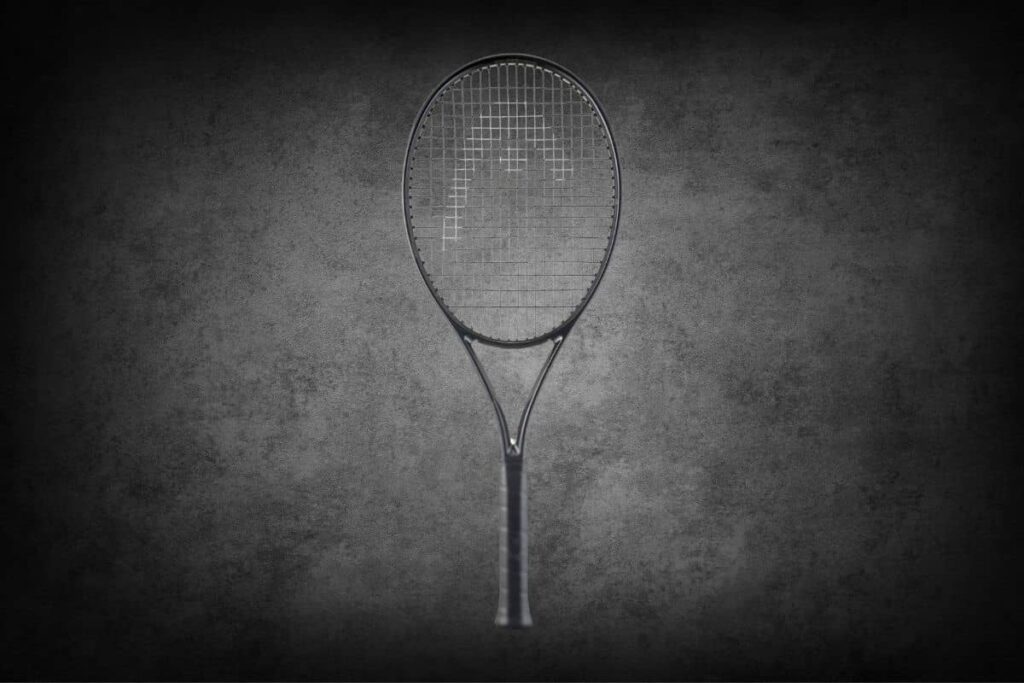
Overview
The HEAD Speed Pro 2024 is a tour-level racquet engineered for advanced players who demand pinpoint accuracy and crisp feedback. With a classic 100 in² head size and a crisp 18×20 string pattern, it blends a modern profile with the control of a player’s stick. Its 310 g unstrung weight and 333 swingweight deliver stability through the court without sacrificing manoeuvrability. Endorsed by Novak Djokovic, this frame excels on fast-paced shots and precise shot-making.
Key Specifications
| Attribute | Specification |
| Head Size | 100 in² (645 cm²) |
| Weight (Unstrung) | 310 g / 10.9 oz |
| Length | 27 in / 68.5 cm |
| Balance | 310 mm / 1.3 in HL (6 pts HL) |
| String Pattern | 18 × 20 |
| Beam Width | 23 mm (even beam) |
| Stiffness (RA) | 60 |
| Swingweight | 333 |
| Composition | Auxetic 2.0, Graphene Inside, Graphite |
| Grip Type | Hydrosorb Pro |
| Recommended String Tension | 21–25 kg / 48–57 lbs |
| Strung Weight | ~329 g |
Signature Technologies
- Auxetic 2.0
A reengineered material that flexes upon impact, giving a livelier feel and more tactile feedback on every shot. - Graphene Inside
Strategically placed graphene strengthens the frame’s core, optimizing energy transfer and stability. - Power Grommets
Enlarged grommet holes allow greater string movement for added power without sacrificing control. - Directional Drilling
Varied hole geometry fine-tunes string bed response, enlarging the sweet spot at key impact zones. - Speed Beam
An aerodynamic, box-style beam profile that cuts through the air, enhancing swing speed. - Speed Pattern
Balanced string spacing that maintains control on flat drives yet still allows respectable spin generation.
Performance & Playability
With its firm 60 RA stiffness, the Speed Pro 2024 offers a crisp, direct feel that seasoned competitors appreciate. The dense 18×20 pattern prioritizes control and directional precision, making it ideal for flat hitters who favour deep, penetrating shots. Despite its control-oriented bed, the Power Grommets and modern frame profile still deliver enough pop for quick attacking swings. On serve and return, the 333 swingweight provides rock-solid stability through impact, translating into confident ball-striking under pressure. Manoeuvrability remains strong thanks to the racquet’s well-balanced weight distribution, allowing for fast racquet head speed at net exchanges and reflex volleys.
2. Tecnifibre T40 305
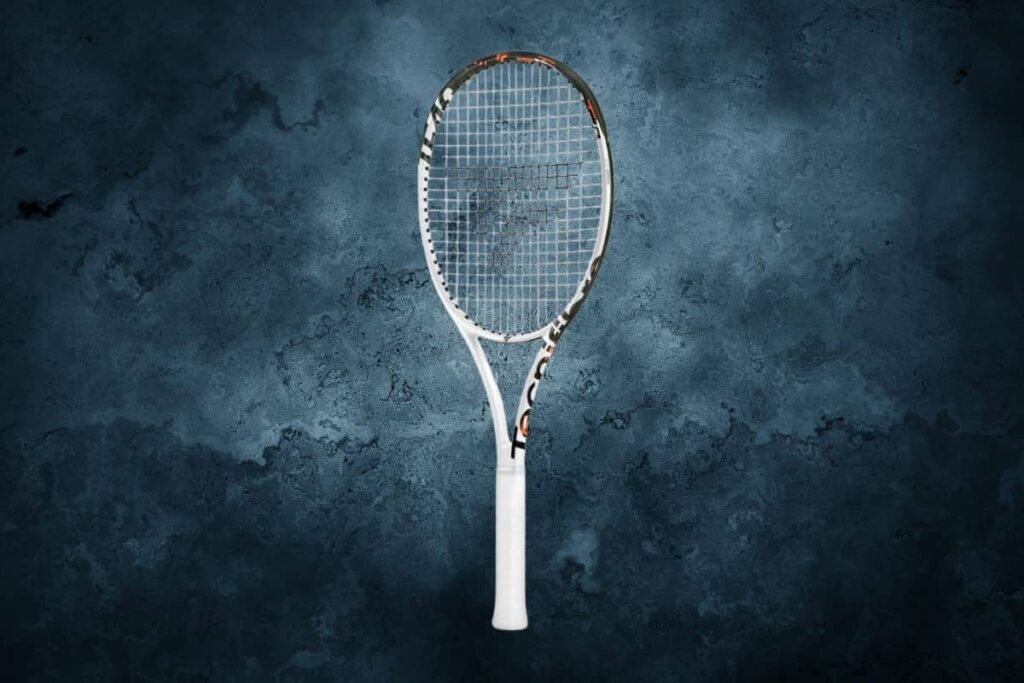
Overview
The Tecnifibre TF-40 305 is a versatile player’s racket engineered to deliver a harmonious blend of control, spin potential, and crisp feedback. At 305 g unstrung with a slightly head-light balance, it offers solid stability through the swing while remaining agile enough for sharp net exchanges and rapid directional changes.
Key Specifications
| Attribute | Specification |
| Range | TF-40 |
| Material | Graphite |
| Head Size | 630 cm² / 98 in² |
| Unstrung Weight | 305 g / 10.8 oz |
| Balance | 325 mm (3 pts HL) |
| Length | 68.6 cm / 27 in |
| String Pattern | 16 × 19 |
| Cross Section (Beam) | 21.7 mm |
| Stringing Presence | Unstrung |
Signature Technologies
- Dynacore Braiding
Integrates high-performance fibres in a 3D weave for exceptional torsional stability and even flex response. - Exoskeleton Technology
Reinforces critical areas of the hoop to maintain frame rigidity at high swing speeds and improve off-centre impact feel. - Extense BG Grommets
Enlarged grommet system that maximizes string movement and snapback, boosting power and spin potential without sacrificing precision.
Performance & Playability
With its midplus head and open 16×19 pattern, the TF-40 305 excels at generating heavy, penetrating topspin while still offering the control needed for tight lines. The moderately stiff 21.7 mm beam ensures a lively ball pocketing sensation, perfect for aggressive baseliners looking to dictate play. The head-light balance enhances manoeuvrability on fast rallies and volley exchanges, and the stable graphite chassis provides a crisp, direct feel on serves and groundstrokes. Overall, this racket caters to all-court competitors who demand a responsive stick that can adapt to power hitters and touch players alike.
3. Wilson Pro Staff 97 v14
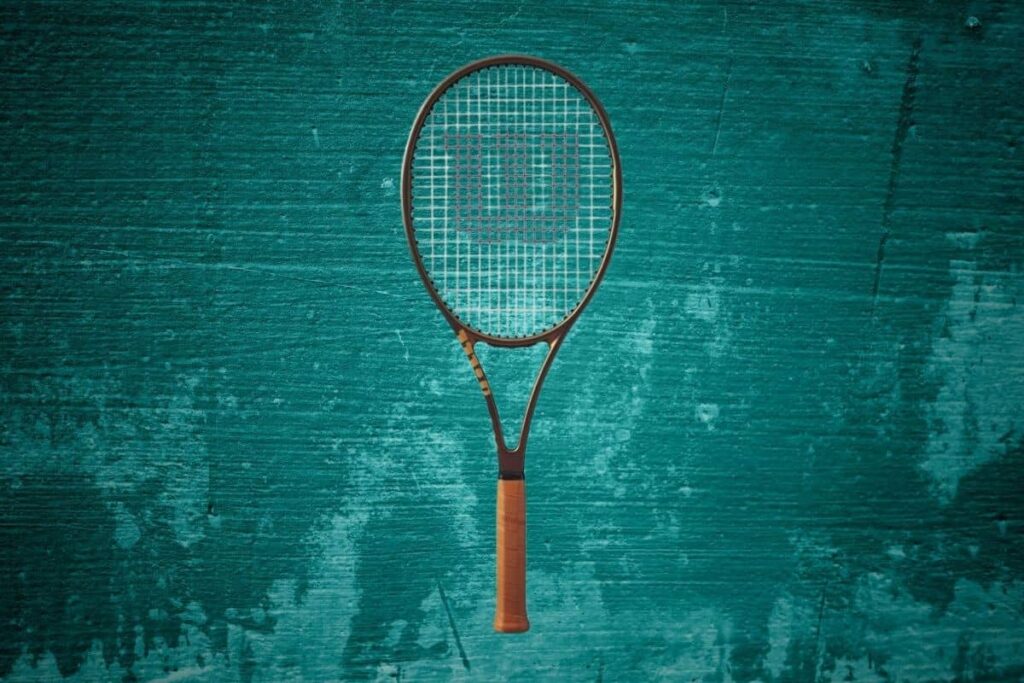
Overview
The Wilson Pro Staff 97 v14 pays homage to a classic player’s frame while integrating modern refinements for today’s advanced competitors. It retains the compact 97 in² head and 21.5 mm Triangular Beam, delivering the signature crisp feel and pinpoint precision that defined the Pro Staff lineage. With an unstrung weight of 315 g and a head-light balance, this racquet offers rock-solid stability on impact yet remains agile enough for rapid net play. The v14 update refines the frame geometry and side-grommet design to enlarge the sweet spot and smooth out swings without sacrificing the Pro Staff’s trademark feedback.
Key Specifications
| Attribute | Specification |
| Head Size | 97 in² / 626 cm² |
| Length | 27 in / 68.58 cm |
| Unstrung Weight | 11.11 oz / 315 g |
| Unstrung Balance | 31.0 cm / 10 pts HL |
| Strung Weight | 11.64 oz / 330 g |
| Strung Balance | 32.0 cm / 7 pts HL |
| Beam Width (Taper System) | 21.5 mm |
| String Pattern | 16 mains × 19 crosses |
Signature Technologies
- Braided Graphite with Kevlar
A multi-fibre layup that blends graphite’s responsiveness with Kevlar’s damping, enhancing feel and reducing vibrations. - Triangular Beam
A flat-sided beam profile that maintains torsional stability and delivers the direct feedback Pro Staff players expect. - Precision Taper System
Variable beam thickness from hoop to throat for optimized stiffness and smooth impact transitions. - Side-Grommet Bridge
Redesigned grommet channels at the 3 and 9 o’clock positions to expand the effective sweet spot and improve ball pocketing.
Performance & Playability
On serves and groundstrokes, the Pro Staff 97 v14 feels exceptionally stable through contact, thanks to its 330 g strung weight and authentic flex profile. The dense 16×19 pattern offers enough string movement for added spin while retaining Supreme control for tight angles and flat drives. Its head-light balance and refined aerodynamics allow for quick recovery in fast exchanges and crisp volley response at net. Overall, this racquet suits advanced baseliners and serve-and-volley players who prize precision, touch, and the unmistakable Pro Staff feel.
4. Yonex EZONE 98
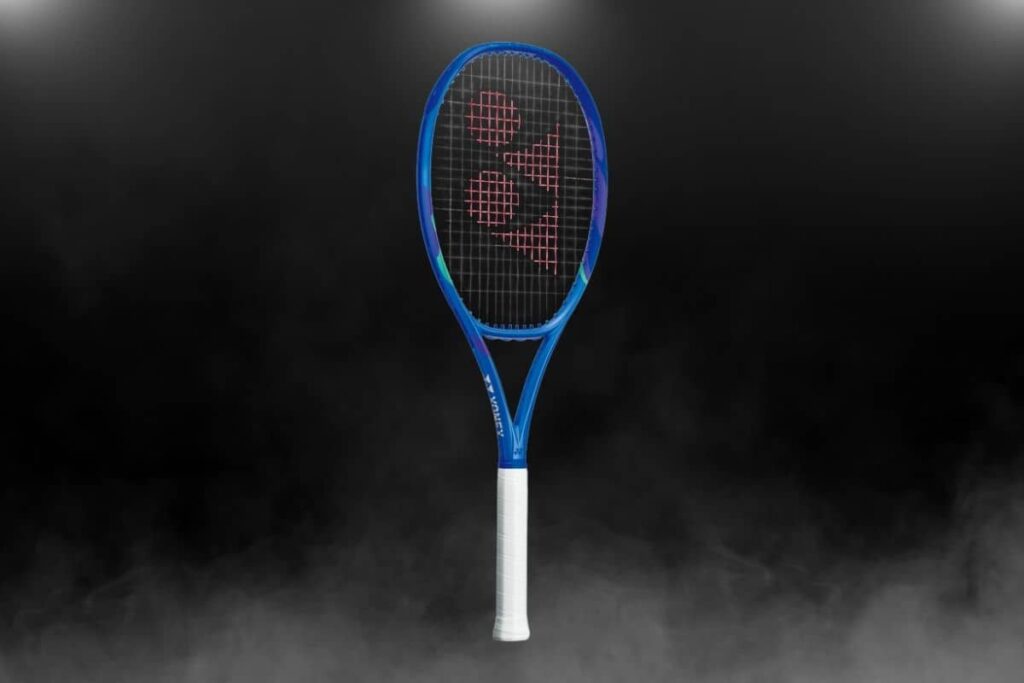
Overview
The Yonex EZONE 98 is a player-friendly frame that balances control, comfort, and spin potential in a 98 in² head. Weighing 305 g unstrung with a 315 mm balance point, it delivers a surprisingly lively feel for its stability. The isometric head shape expands the sweet spot, while a blend of high-modulus graphite and cutting-edge materials provides a plush response and crisp feedback on every shot.
Key Specifications
| Attribute | Specification |
| Head Size | 98 in² (632 cm²) |
| Unstrung Weight | 305 g / 10.8 oz |
| Length | 27 in / 68.6 cm |
| Beam Width | 23.8 – 24.5 – 19.5 mm |
| Balance Point | 315 mm |
| Material | HM Graphite, 2G-NAMD SPEED, VDM, MINOLON |
| String Pattern | 16 × 19 |
| Recommended Tension | 45 – 60 lbs (20 – 27 kg) |
| Recommended Strings | POLYTOUR PRO / POLYTOUR STRIKE / REXIS SPEED |
| Colour | Aqua Night Black |
Signature Technologies
- 2G-NAMD SPEED
A next-generation graphite/resin hybrid that bonds carbon fibres more securely for faster rebound and extra power on every hit. - Vibration Dampening Mesh (VDM)
A woven mesh inside the handle that absorbs harsh vibrations, enhancing comfort and touch without deadening feel. - MINOLON
A shock-absorbing synthetic resin layer in the shaft that softens impact and sharpens feedback through the frame. - Isometric Head Shape
Yonex’s trademark squared-off design increases the intersection of main and cross strings, enlarging the sweet spot for more forgiveness.
Performance & Playability
On groundstrokes, the EZONE 98 blends crisp control with a surprising pop thanks to its beam design and 2G-NAMD SPEED layup. The open 16×19 pattern offers easy string bite for heavy spin, while VDM and MINOLON technologies tame harsh impact shock, keeping feel plush on powerful drives. Serves fly off the frame with precision and comfort, and the 315 mm balance ensures quick recovery in fast exchanges. At net, the 305 g racquet remains nimble, delivering crisp volleys and accurate placements. This stick is ideal for aggressive all-court players seeking a versatile, arm-friendly workhorse.
Also: Read about the benefits of playing tennis.
IV. Top 4 Rackets for Intermediate Players (2025)
Intermediate players need a balanced blend of power, spin, and manoeuvrability to elevate their game. Here are the four standout rackets for 2025—each tested for playability, comfort, and performance.
1. HEAD Speed MP Legend Edition
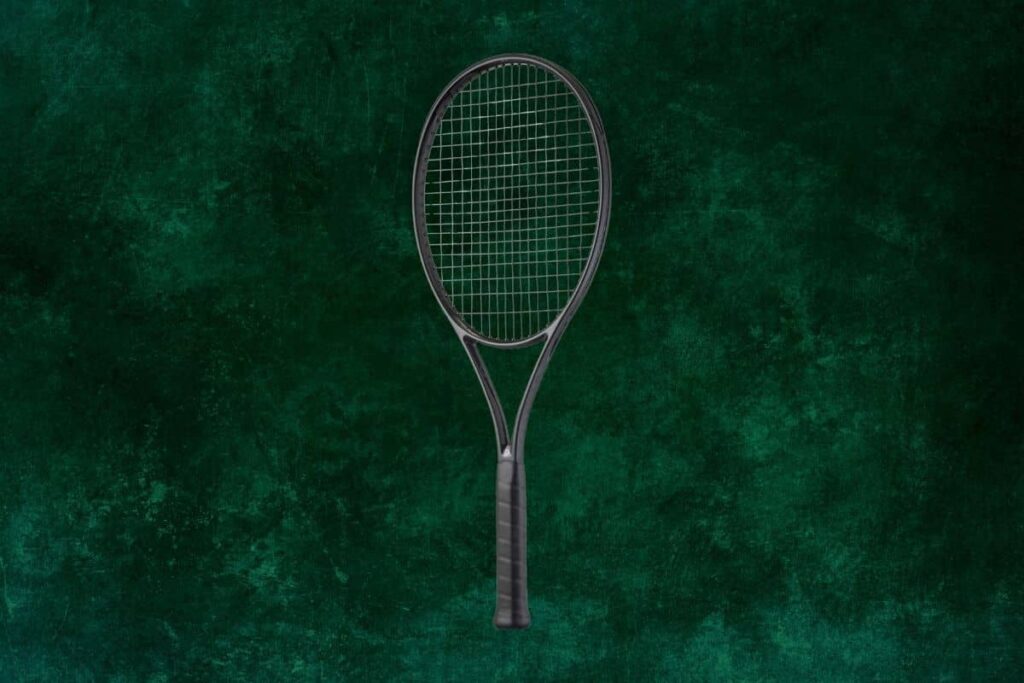
Overview
The Speed MP Legend is a midplus frame that marries stability with nimble handling, crafted for advanced baseliners seeking a lively yet controlled feel. At roughly 300g unstrung, it swings like a lighter stick but packs punch once the ball embeds in the stringbed. Its 100 in² head and balanced 320 mm beam profile deliver a forgiving sweet spot without compromising precision, making it a versatile choice for aggressive all-court players.
Key Specifications
| Attribute | Specification |
| Head Size | 100 in² (645 cm²) |
| Length | 27 in (68.6 cm) |
| Unstrung Weight | ~300 g (10.6 oz) |
| Unstrung Balance | 320 mm (1 pts HL) |
| Swingweight | 330 |
| Stiffness (RA) | 60 |
| Beam Width | 23 mm (even beam) |
| String Pattern | 16 × 19 |
| Composition | Auxetic 2.0, Graphene 360+, Graphite |
| Grip Type | Hydrosorb Pro |
| Recommended Tension | 48–57 lbs (21–26 kg) |
Signature Technologies
- Auxetic 2.0
A reengineered polymer weave that flexes outward on impact, boosting dwell time for enhanced feel and control. - Graphene 360+
Infuses high-quality graphene at key flex zones, improving energy transfer and overall stability without adding bulk. - Speed Beam
A clean, box-shaped beam profile designed to cut through air resistance, accelerating swing speed. - Power Grommets
Enlarged grommet holes allow greater string movement for extra pop on demand, while retaining directional control. - Hydrosorb Pro Grip
A tacky, moisture-wicking grip that maximizes comfort and minimizes slippage during intense rallies.
Performance & Playability
On groundstrokes, the Legend’s 16×19 pattern and 60 RA stiffness deliver a crisp response with ample string bite for spin. You’ll notice a lively launch off both flat drives and heavy topspin strokes, yet the dense sweet spot keeps your targeting razor-sharp.
Serving and returning feel rock-solid thanks to the 315 g strung weight and 330 swingweight, which dampen torque on off-centre hits. At net, the head-light balance allows quick racket head recovery, making crisp volleys feel effortless. Overall, the Speed MP Legend thrives in modern, aggressive all-court play, rewarding fast swings with controlled power and spin.
2. Yonex EZONE 98L
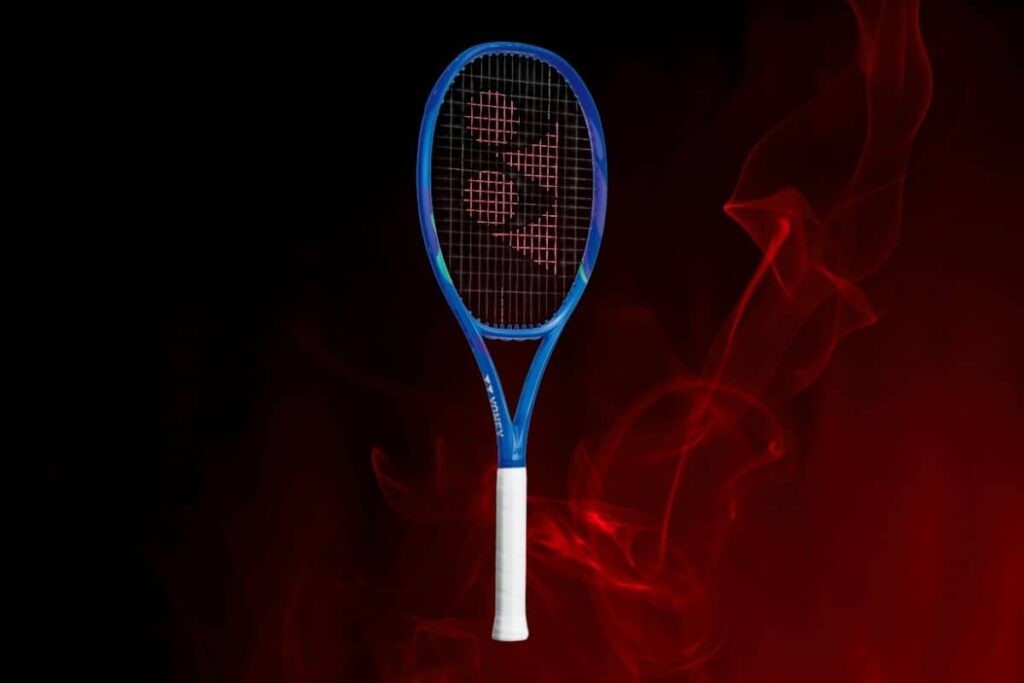
Overview
The EZONE 98L is a lightweight, arm-friendly frame tailored for intermediate players seeking a blend of power, spin, and comfort. Its 98 in² isometric head and 285 g unstrung weight create a quick, manoeuvrable feel, while the 330 mm balance point adds stability through impact. This racquet’s friendly profile helps generate easy pace and forgiveness on off-centre hits.
Key Specifications
| Attribute | Specification |
| Head Size | 98 in² / 632 cm² |
| Unstrung Weight | 285 g / 10.1 oz |
| Length | 27 in / 68.6 cm |
| Beam Width | 23.8 – 24.5 – 19.5 mm |
| Balance Point | 330 mm |
| Material | HM Graphite / 2G-NAMD SPEED / VDM / MINOLON |
| String Pattern | 16 mains × 19 crosses |
| Recommended Strings | POLYTOUR PRO / POLYTOUR STRIKE / REXIS SPEED |
| Stringing Advice | 40 – 55 lbs (18 – 25 kg) |
| Colour | Deep Blue |
Signature Technologies
- ISOMETRIC head shape increases the sweet spot by 7 % for more forgiveness on off-centre strikes.
- 2G-NAMD SPEED embeds a next-gen graphite/resin matrix for faster rebound and enhanced power.
- Vibration Dampening Mesh (VDM) layers in the handle absorb harsh shock without dulling feel.
- MINOLON synthetic resin in the shaft softens impact and sharpens feedback through the frame.
Performance & Playability
The EZONE 98L excels in providing a plush yet lively response. Its open 16×19 pattern and low-to-medium stiffness allow the strings to bite the ball for explosive spin, while the head-light 330 mm balance ensures quick recovery for fast rallies and crisp volleys. Intermediate players will appreciate how the light 285 g frame reduces arm strain on prolonged sessions yet still delivers enough stability on serves and groundstrokes to build confidence in shot-making.
For players transitioning from a heavier stick, this racquet strikes a harmonious balance between manoeuvrability and control, making it an ideal workhorse for modern all-court tactics.
3. Babolat EVO Drive Tour
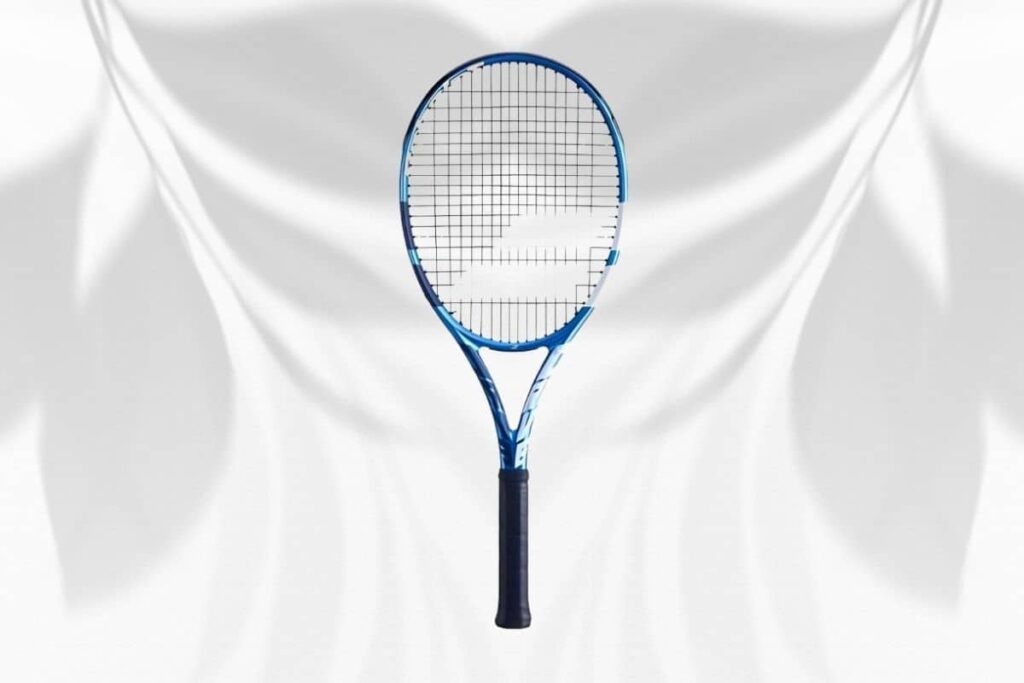
Overview
The EVO Drive Tour is a lightweight, spin-focused racquet crafted for intermediate players craving effortless pace and manoeuvrability. Its generous 102 in² head and 285 g unstrung weight allow for quick acceleration through the hitting zone. A medium-stiff 70 RA flex and a 290 swingweight deliver stability on impact, while the aerodynamic beam provides a lively, responsive feel. This Tour edition elevates the classic Drive line with enhanced spin potential and comfort.
Key Specifications
| Attribute | Specification |
| Head Size | 102 in² / 658 cm² |
| Length | 27 in / 68.5 cm |
| Unstrung Weight | 285 g / 10.1 oz |
| Swingweight | 290 |
| Unstrung Balance | 320 mm |
| String Pattern | 16 mains × 19 crosses |
| Beam Width | 23 – 26 – 23 mm |
| Stiffness (RA) | 70 |
| Composition | High-modulus graphite |
| Recommended Strings | Xcel, AddiXion |
| Recommended Grip | Syntec Evo |
| Recommended Tension | 23–25 kg / 50–55 lbs |
Signature Technologies
- Woofer System
Optimizes frame-to-string contact for longer dwell time, enhancing control and comfort. - Spin Blade Grooves
Textured grommet channels increase string snap-back, sharpening bite and topspin. - Light Lay-Up Composite
A specialized graphite weave reduces weight without compromising rigidity. - FSI Spin+ Pattern
Wider string spacing to boost movement, allowing heavy spin generation. - Paraloid B72 Resin
High-performance epoxy that dampens vibrations for an arm-friendly feel.
Performance & Playability
From the baseline, the EVO Drive Tour excels at producing heavy topspin and precise angles. The open 16×19 pattern and Spin Blade technology let strings grip the ball aggressively, while the 70 RA flex offers a lively response. Serves benefit from a low swingweight, launching with both speed and rotation, and the 320 mm balance ensures quick recovery for fast exchanges. Despite its dynamic character, Paraloid B72 maintains a comfortable, dampened feel—making extended rallies and multi-set matches more forgiving.
4. Wilson Blade 100UL V9
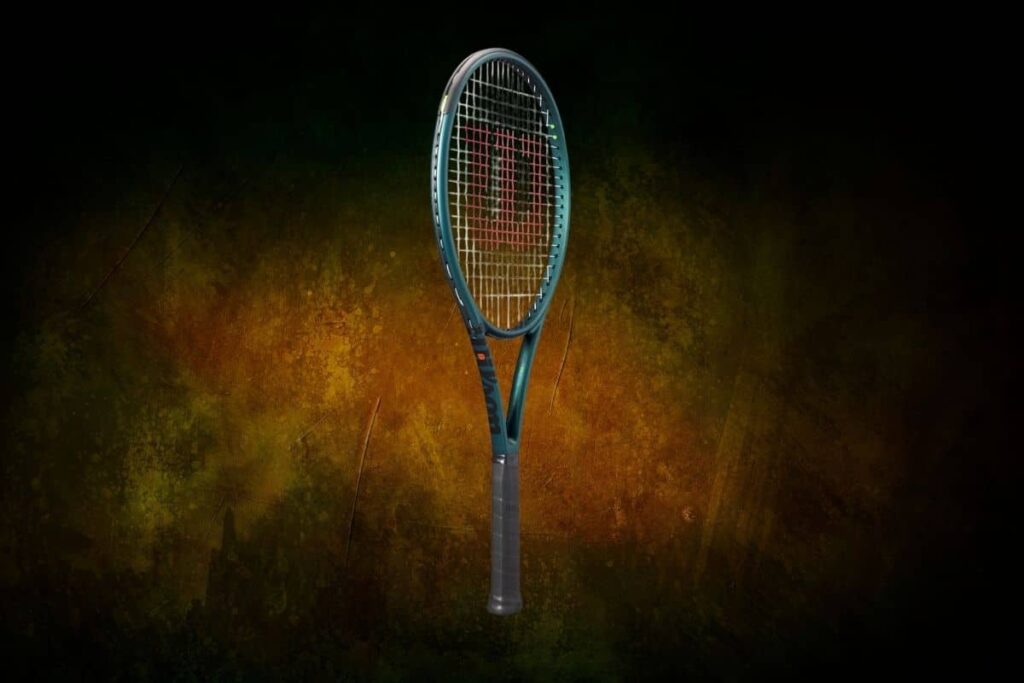
Overview
The Blade 100UL V9 is the lightest member of Wilson’s storied Blade family, engineered to help dedicated beginners and early intermediates, master stroke mechanics with confidence. At just 265 g unstrung, it swings exceptionally fast, yet its refined layup and modern beam deliver the crisp control and feel the Blade line is known for. The V9 update adds StableFeel technology for extra stability and easier access to power, while retaining the precise feedback that inspires aggressive yet accurate shot-making.
Key Specifications
| Attribute | Specification |
| Head Size | 100 in² / 645 cm² |
| Length | 27 in / 68.58 cm |
| Unstrung Weight | 265 g / 9.4 oz |
| Strung Weight | 281 g / 9.9 oz |
| Unstrung Balance | 33.5 cm / 2 pts HL |
| Strung Balance | 34.5cm / 1 pt HH |
| Swingweight | 304 |
| Stiffness (RA) | 65 |
| Beam Width | 22 mm / 22 mm / 22 mm |
| Composition | Braided Graphite + Basalt |
| Grip Type | Wilson Pro Performance |
| String Pattern | 16 mains × 19 crosses |
| Mains Skip | 8T, 8H |
| String Tension | 50–60 lbs / 22–27 kg |
Signature Technologies
- Direct Connect
The butt cap is fused directly to the carbon-fibre handle, boosting stability and delivering more consistent feel across shots. - FortyFive Layup
A 45° angled fibre orientation adds lateral flexibility, complementing the modern game’s vertical stroke mechanics for explosive power. - StableFeel
A slightly firmer layup introduced in V9 that enhances racket stability on off-centre hits and makes accessing power more intuitive.
Performance & Playability
On full swings, the Blade 100UL V9 rewards you with surprising pop and spin—thanks to its open 16×19 pattern and stable beam—while still feeling ultra-manoeuvrable in tight exchanges. Serves zip off the strings with crisp feedback, and its low swingweight lets you swing freely without sacrificing baseline stability. At net, the light headspeed makes reflex volleys and rapid directional changes effortless. Overall, the V9 balances the classic Blade precision with modern ease-of-use, making it an ideal weapon for improving players stepping up to a high-performance control frame.
V. Top 2 Rackets for Beginners (2025)
Novice players need a racket that’s forgiving, lightweight and confidence-boosting. Below, we dive deep into the two best beginner frames of 2025—complete with specs and performance notes.
1. HEAD Boom TEAM
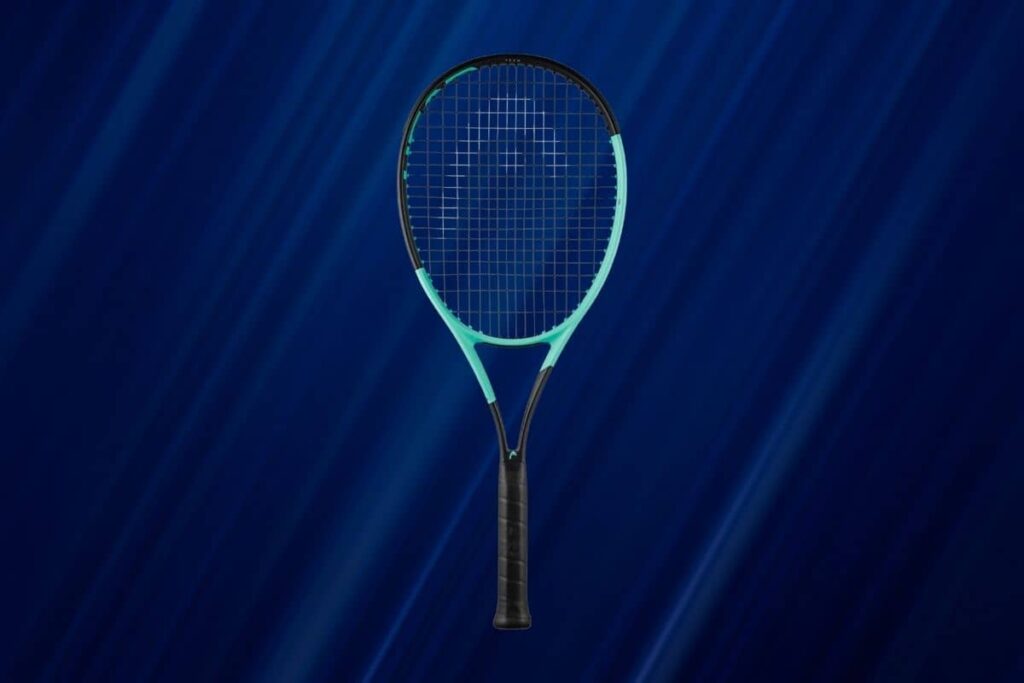
Overview
The Boom TEAM is a lightweight, spin-generating frame crafted for club-level and junior competitors who crave effortless swing speed and comfort. With a 102 in² head and just 275 g unstrung, it feels nimble through rallies while offering a forgiving sweet spot. Its Boom series DNA emphasizes lively ball pocketing and easy power, making it perfect for players ramping up their pace and spin without overloading their arm.
Key Specifications
| Attribute | Specification |
| Head Size | 102 in² (658 cm²) |
| Length | 27 in (68.58 cm) |
| Unstrung Weight | 275 g (9.7 oz) |
| Balance (Unstrung) | 330 mm (0.5 pts HL) |
| Swingweight | 309 |
| Stiffness (RA) | 62 |
| Beam Width | 25 / 25 / 22 mm |
| Composition | Auxetic 2.0, Graphene Inside, Graphite |
| Grip Type | Hydrosorb Pro |
| String Pattern | 16 mains × 19 crosses |
| Mains-Skip Configuration | 7T, 9T, 7H, 9H (two-piece, no shared holes) |
| Recommended Tension | 21–25 kg (48–57 lbs) |
| Colour | Black / Coral |
Signature Technologies
- Auxetic 2.0
A flexible polymer weave that expands on impact, boosting dwell time and enhancing feel across the stringbed. - Graphene Inside
Strategically places graphene at key flex zones to strengthen the frame, improve stability on off-centre hits, and optimize energy transfer. - Two-Piece Mains-Skip String Bed
Unique grommet layout (7T, 9T, 7H, 9H) maximizes string movement for extra pop and spin while preserving directional control. - Hydrosorb Pro Grip
A moisture-wicking, cushioned grip that maintains tackiness during long sessions, reducing slippage and fatigue.
Performance & Playability
From the baseline, the Boom TEAM’s open 16×19 pattern and lightweight chassis allow the strings to bite the ball for effortless topspin and rapid pace generation. Its 62 RA flex and Boom-series beam profile deliver a lively, catapult-like feel—ideal for players seeking easy power without a heavy swing. On serves, the low mass facilitates quick racket head speed, producing surprising depth and rotation for such a light frame. At net, the 4 pts HL balance ensures fast recovery and crisp volley response. Overall, the Boom TEAM excels as an entry-level tour de force, empowering emerging players to develop spin-driven, all-court tennis with comfort and confidence.
2. Wilson Hyper Hammer 5.3
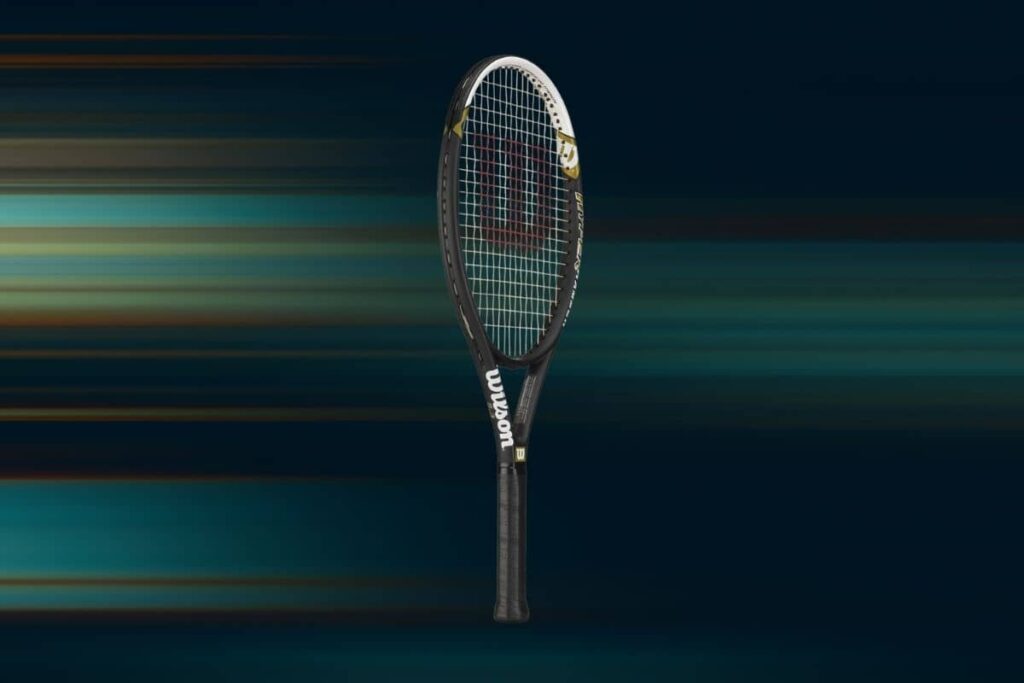
Overview
The Hyper Hammer 5.3 is Wilson’s oversized power frame crafted for beginners and intermediate players seeking effortless pace and generous forgiveness. The massive 110 in² head and elongated 27.5 in length create a significantly enlarged sweet spot, while the head-heavy balance amplifies leverage on groundstrokes and serves. Its blend of Hyper Carbon and graphite construction delivers a lively, catapult-like response on every shot.
Key Specifications
| Attribute | Specification |
| Head Size | 110 in² / 709.7 cm² |
| Length | 27.5 in / 69.9 cm |
| Unstrung Weight | 237 g / 8.4oz |
| Strung Weight | 254 g / 8.9 oz |
| Unstrung Balance | 37.5 cm / 8 pts HH |
| Strung Balance | 38.5 cm / 11 pt HH |
| Swingweight | 304 |
| Stiffness (RA) | 70 |
| Beam Width | 23.5 / 29 / 24.5 mm |
| String Pattern | 16 mains × 20 crosses |
| Mains-Skip Configuration | 7T, 9T, 7H, 9H (two-piece, no shared holes) |
| Composition | Hyper Carbon (15%) / Graphite (85%) |
| Grip Type | Cushion Aire Conform Grip |
| Recommended Tension | 55–65 lbs / 25–29 kg |
Signature Technologies
- Hyper Carbon construction blends high-modulus carbon fibres with graphite to boost frame stability and power.
- Oversized head design enlarges the sweet spot for enhanced forgiveness and easy power generation.
- Two-piece mains-skip grommet pattern increases string movement for extra dwell time, pop, and spin.
- Cushion Aire Conform Grip delivers comfortable, moisture-wicking cushioning for long sessions.
- Head-heavy balance enhances racket inertia, providing added pace on groundstrokes and serves.
Performance & Playability
From the baseline, the Hyper Hammer 5.3 excels at delivering easy power with minimal effort thanks to its oversized head and head-heavy balance. The steep beam profile and high stiffness rating translate to a lively, trampoline-like response, allowing players to generate depth on both flat and topspin strokes without requiring extreme swing speed.
On serve, the added leverage from the 27.5 in frame and head-heavy design produces effortless pace and surprising penetration. Net play remains manageable for developing players, as the light unstrung weight combined with a stable strung mass provides enough steadiness for crisp volleys while preserving quick head speed for rapid exchanges.
VI. Bonus Sections

In addition to our top racket picks, savvy players stay ahead by tracking industry breakthroughs and mastering demo etiquette. Below, we explore 2025’s hottest racket innovations and offer a step‐by‐step guide to demoing like a pro.
A. 2025 Innovations & Trends in Racket Technology
- AI-Tuned Frame Engineering
• What’s new: Manufacturers harness machine learning to optimize fibre layup, flex patterns and mass distribution for each player profile. For example, Wilson’s “Smart Geometry” prototyping uses AI simulations to refine beam stiffness in milliseconds.
• Why it matters: Personalization at scale ensures rackets deliver ideal power-to-control ratios without manual trial and error.
• Learn more: See Tennishub.in’s deep dive on AI-Driven Racket Design (Tennis.com, DA 91). - Eco-Friendly & Recycled Materials
• What’s new: Brands like Head and Tecnifibre lead the charge with recycled carbon fibre frames and bio-resin epoxies. These materials cut CO₂ emissions by up to 30% during manufacturing.
• Why it matters: As players demand greener gear, sustainable rackets maintain performance while shrinking environmental footprints. - 3D-Printed Custom Components
• What’s new: Select lines now integrate 3D-printed throat inserts and butt-caps, allowing micro-adjustments to stiffness, balance and ergonomics.
• Why it matters: This breakthrough lets pro shops fabricate bespoke tuning parts on demand—no factory recall required. - Smart Sensors & Embedded Analytics
• What’s new: In-frame sensors from companies like PlaySight record shot speed, spin rate and sweet-spot accuracy in real time, transmitting stats to your phone.
• Why it matters: Instant data empowers coaches and players to fine-tune technique and equipment choices mid-session. - Nano-Infused Vibration Dampening
• What’s new: Babolat’s Pure Feel Cortex now incorporates nanoscopic flax fibres to filter shock at the molecular level—enhancing comfort without sacrificing crisp feedback.
• Why it matters: These nano-materials minimize harmful vibrations while preserving direct ball feel—a win for aggressive hitters with sensitive elbows. - Hybrid String & Frame Systems
• What’s new: Integrated “woofers” (grommets that move with strings) and interwoven string/frame tech improve energy transfer and sweet-spot consistency.
• Why it matters: These innovations deliver power and spin without resorting to stiffer, more injury-prone frames.
• Learn more: Visit Tennis Warehouse’s String & Woofers Explained (Tennis Warehouse, DA 85).
B. How to Demo & Demo Etiquette
Testing rackets before purchase separates serious players from casual shoppers. Follow this roadmap to get the most out of every demo—while showing respect to demo providers.
- Locate the Right Demo Program
• In-Store Demos: Many pro shops and club stores offer on-court demo days.
• Mail-Order Demos: Services like Tennis Warehouse’s Demo Program ship rackets directly to your door for 3–5 days.
• Club Partnerships: Local USTA-affiliated clubs often run quarterly demo events. - Schedule & Prepare
• Book in Advance: Popular demo slots fill quickly—reserve at least two weeks ahead.
• Bring Essentials: Court shoes, favourite strings (stubby samples help), a notebook or smartphone for logging specs and impressions.
• Warm Up Consistently: Use your own racket for baseline drills before switching to demos—this normalizes muscle memory. - Conduct Structured Testing
• Metric Tracking: Record key data—serve speed, groundstroke spin, volley control—over standardized drills.
• Head-to-Head Comparison: Test two rackets back-to-back using identical swing patterns to isolate feel differences.
• Subjective Notes: Rate comfort, feedback, power and confidence on a 1–10 scale for each demo. - Practice Proper Etiquette
• Handle with Care: Avoid slamming rackets into ball machines or impact walls.
• Respect Time Limits: If the provider allocates 30 minutes per racket, stick to the schedule so others can test.
• Return in Original Condition: Re-string loose demos if necessary; wipe grips and purfling before packing.
• Provide Feedback: Offer constructive comments to shop staff—they appreciate insights and it fosters better service. - Post-Demo Follow-Up
• Compare Notes: Revisit your data log and identify 2–3 finalists.
• Demo Extensions: If undecided, inquire about an extended demo—many programs allow a second week for a nominal fee.
• Make the Purchase: Armed with firsthand metrics and subjective preference, you’ll feel confident investing in your new frame.
By embracing these cutting-edge technologies and following best-practice demo protocols, you’ll not only pick the perfect racket for 2025 but also stay at the forefront of tennis innovation.
VII. The Final Serve: Selecting Your Perfect Racket
At this point, you’ve explored the specs, tested the latest innovations, and zeroed in on rackets tailored to your skill level. Now comes the most critical step: trusting your experience. First, revisit your on-court notes. Compare how each racket felt at impact—did it inspire confidence on your serve? Did it deliver the spin you wanted on heavy topspin strokes? By matching those subjective impressions to the objective metrics you logged, you’ll narrow your options to the one or two frames that truly resonate with your game.
Next, don’t underestimate the power of fine-tuning. Once you pick a model, experiment with string type and tension to unlock its full potential. A softer multifilament string can soften the feel of an otherwise stiff frame, while a polyester string at a slightly lower tension can magnify your spin and power without compromising control. Similarly, an over grip or lead tape at the handle can adjust balance and weight distribution until the racket feels like a natural extension of your arm.
Moreover, remember that your ideal racket may evolve alongside your game. As you refine your technique and build strength, you might crave more control or added plow through power. Therefore, plan to revisit your choice every 12–18 months. Schedule follow-up demos or borrow a friend’s frame to see if it still meets your evolving needs. Staying curious and flexible will keep you ahead of the curve—and ensure your equipment never holds you back.
Finally, embrace the journey. The quest for the perfect racket is as much about self-discovery as it is about gear. Each on-court test teaches you something new about your swing, your preferences and the subtle nuances that separate “good” from “great.” So, head to the court with purpose, trust your data and enjoy the process. When you finally grip that racket that checks every box—power, comfort, control, and confidence—you’ll know you’ve served well.
VIII. FAQ (Frequently Asked Questions)
1. How do I choose the right grip size for my tennis racket?
First, measure the distance from the middle crease of your palm to the tip of your ring finger. Match that length (in inches) to the grip size chart—most adult rackets range from 4⅛” to 4¾”. If you’re between sizes, opt for the smaller one and build up with an over grip. A proper fit prevents slippage, maximizes leverage, and reduces injury risk.
2. What string tension should I use for optimum performance?
String tension directly influences power, control, and comfort:
- Lower tension (50–55 lbs): More power and a livelier feel—ideal for beginners and spin-heavy hitters.
- Mid tension (55–60 lbs): Balanced power/control suitable for most intermediate players.
- Higher tension (60–65 lbs+): Enhanced control and precision—favoured by advanced competitors.
Always start at the manufacturer’s recommended tension range printed on your racket throat. Then, tweak in 2–3 lb increments until you hit your sweet spot.
3. How often should I restring my racket?
A good rule of thumb is “play hours equals pounds” (e.g., restring at 50 lbs of tension after 50 hours of play). Frequent weekend warriors might restring every 4–6 weeks, while casual players can go 3–6 months. Strings lose tension gradually, so even if they don’t break, you’ll notice diminished spin, less power, and a dead feel.
4. Should I demo rackets online or in person?
Both options work, but they cater to diverse needs:
- In-store demos let you assess on your home court and get real-time expertise from pros. Use Babolat’s Demo Locator or Wilson’s On-Court Demo Program to find events near you.
- Mail-order demos (e.g., Tennis Warehouse Demo Program) let you trial multiple rackets over several days in familiar conditions. Just remember to record your performance metrics for each frame.
5. What factors determine whether I need a one-handed or two-handed backhand racket setup?
Technically, rackets don’t change between backhand styles—but certain specs can complement your technique:
- One-handers often prefer heavier, head-light rackets (≈11.5 oz strung) for stability and leverage on long levers.
- Two-handers might lean toward slightly lighter frames (10–11 oz strung) for quicker racket head speed at contact.
Demo both racket types if possible and see which feels more natural during your typical backhand swing.
6. Which strings work best for beginners versus advanced players?
- Beginners: Synthetic gut or multifilament strings at mid-low tension (50–55 lbs) offer comfort, power, and durability.
- Intermediates: Hybrid setups—polyester mains for durability/spin, multifilament crosses for comfort—strike a nice balance.
- Advanced: Full polyester strings at higher tension (60–65 lbs+) deliver control, spin, and crisp feedback.
7. Are extended-length rackets (27.5″+) advantageous for beginners?
Longer rackets add reach on serves and groundstrokes, translating to extra leverage and power. However, they require slightly more wrist and shoulder stability. Beginners under 5’6″ or those just building swing mechanics may prefer standard 27″ frames for manoeuvrability.
8. How can I customize my racket’s balance and weight at home?
You can fine-tune your frame’s feel by:
- Adding lead tape (1 g increments) at the 3 & 9 o’clock positions for extra stability.
- Wrapping an over grip or tape under the butt cap to shift balance headlight.
- Swapping out the factory grip for a lighter or heavier aftermarket handle.
9. What should I consider if I have a history of tennis elbow or wrist pain?
Protecting your arm starts with frame selection and string choice:
- Choose rackets with low stiffness ratings (RA 55–60) and built-in dampening tech (e.g., Wilson’s Countervail®, Babolat’s Cortex®).
- Pair with comfortable strings—multifilament or softer hybrids at moderate tension (50–55 lbs).
- Ensure correct grip size and maintain proper swing mechanics.
10. How often should I upgrade my racket?
Unlike shoes, rackets don’t deteriorate visibly. Instead, upgrade when:
- You’ve outgrown your current frame’s specs (e.g., need more control or power).
- You notice persistent arm discomfort despite proper stringing and grip.
- New technological breakthroughs (e.g., AI-tuned frames, nanomaterials) promise a meaningful performance boost.
On average, serious players cycle through a new model every 12–18 months.

